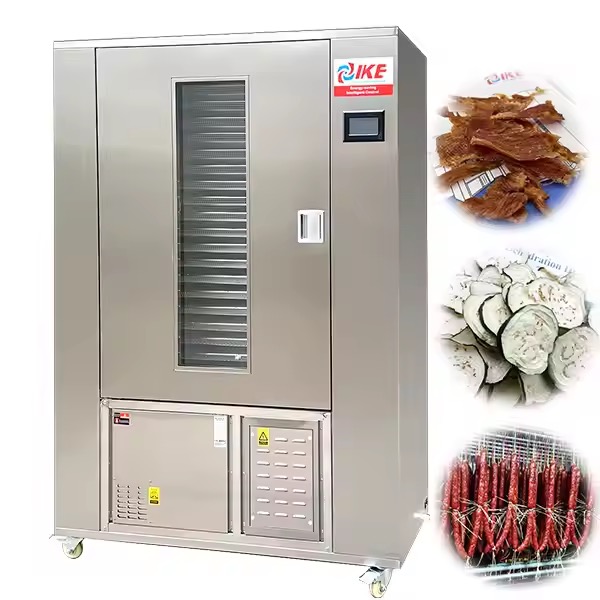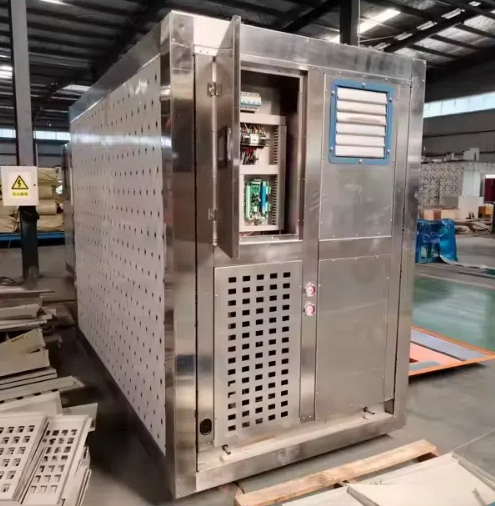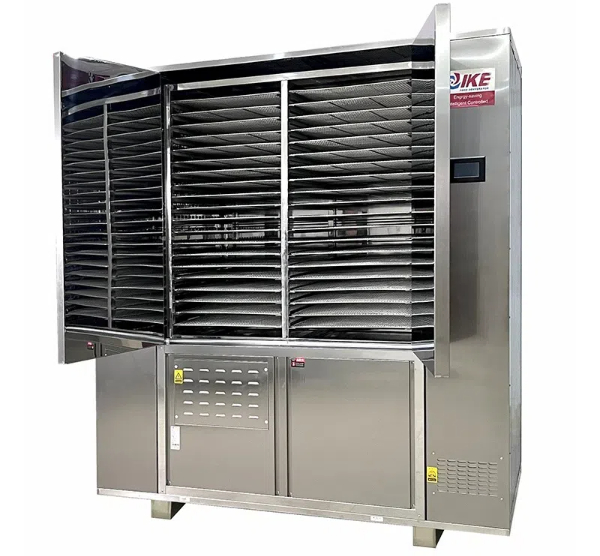
Content Menu
● What is a Cabinet Type Dehydrator?
● Key Components and Their Functions
● The Dehydration Process Explained
● Temperature and Humidity Control
● Advantages of Cabinet Type Dehydrators
● Applications in Food Processing
● Case Studies and Examples
● Innovations and Future Trends
● Maintenance and Cleaning Tips
● Conclusion
● FAQ
>> 1. What are the key benefits of using a cabinet type dehydrator?
>> 2. How do I maintain a cabinet type dehydrator?
>> 3. What types of food can I dry using a cabinet type dehydrator?
>> 4. How does a cabinet type dehydrator ensure even drying?
>> 5. Are cabinet type dehydrators energy efficient?
● Citations:
Food dehydrators are devices that remove moisture from food to aid in its preservation. Drying food is a method of preservation for fruits, vegetables, and meats. Cabinet dehydrators are designed for long-term food preservation, with precise control over time, temperature, and humidity. They use intake air from the surrounding environment, displacing it over electrical heating elements via a blower.

What is a Cabinet Type Dehydrator?
A cabinet dehydrator is a type of food drying equipment designed like a cabinet. It controls the drying process with high precision. It is typically used for the long-term preservation of food. These dehydrators control the temperature, humidity, and air flow. This ensures consistent and effective drying. The enclosed design of these dehydrators not only provides a controlled environment but also protects the food from external contaminants such as dust and insects, ensuring a cleaner and safer drying process. Cabinet dehydrators are available in a range of sizes, from small, countertop units suitable for home use to large, industrial-scale models capable of processing significant quantities of food.
Key Components and Their Functions
Cabinet dehydrators consist of several key components that work together to achieve optimal dehydration. Understanding the function of each component is essential for maximizing the dehydrator's efficiency and lifespan.
-Cabinet: The cabinet has side, bottom, top, back walls, and a front, air-tight door. The walls are often insulated to maintain a consistent internal temperature. Insulation materials vary but commonly include foam or double-walled metal construction. The airtight door is crucial for maintaining a stable drying environment, preventing temperature fluctuations and ensuring consistent drying.
-Heating Element: Electrical heating elements elevate the temperature of the air. The dehydrating temperature should not exceed 145°F (63°C). The heating elements are typically made of resistance wire, such as nichrome, which converts electrical energy into heat. The placement of the heating element is also significant; it is often positioned to allow for even heat distribution throughout the cabinet.
-Air Blower: An air blower introduces influent air into the cabinet. It maintains suitable humidity within the dehydrating interior. The blower speed control helps maintain humidity well below saturation. The air blower is a critical component, ensuring that the heated air is circulated evenly around the food. Without proper air circulation, some areas of the food may dry more quickly than others, leading to inconsistent results. The speed of the blower is often adjustable, allowing users to fine-tune the airflow based on the type of food being dehydrated.
-Air Displacement Channel: The air displacement channel constricts air flow. It progressively enlarges beyond the lower end of the heating element. This design helps to distribute the heated air evenly throughout the cabinet, ensuring that all trays receive a consistent flow of warm, dry air.
-Chimney: A chimney on top of the cabinet allows exhaust to vent to the atmosphere. This exhaust carries away moisture-laden air, preventing condensation buildup inside the cabinet.
-Shelves: Removable shelves hold the food items. They allow for easy access and optimal air circulation around the food. The shelves are typically made of stainless steel or plastic, designed to be food-safe and easy to clean. The spacing between shelves is also important; it should be sufficient to allow for adequate airflow around the food items.
-Controls: Thermostats control the electrical heating elements. Controls maintain and monitor temperature within a suitable range to efficiently dehydrate without excessive vitamin loss. They also control the rate of air displacement to maintain the best humidity level. Modern cabinet dehydrators often feature digital controls with precise temperature and humidity settings. Some models also include timers that automatically shut off the dehydrator after a set period, preventing over-drying and saving energy.

The Dehydration Process Explained
The dehydration process in a cabinet dehydrator is a carefully controlled sequence of steps designed to remove moisture from food while preserving its nutritional content and flavor.
1. Air Intake: The process begins with the intake of air from the surrounding environment. The air is drawn into the dehydrator through vents or openings, often filtered to remove dust and other contaminants.
2. Air Heating: The air passes over electrical heating elements, raising its temperature. The temperature is carefully controlled to ensure that the food dries properly without cooking or scorching. The specific temperature required varies depending on the type of food being dehydrated.
3. Air Circulation: A blower forces the heated air into the dehydrator cabinet. The air is circulated evenly around the food on the shelves, ensuring that all surfaces are exposed to the warm, dry air. This even circulation is crucial for consistent drying.
4. Moisture Removal: The heated air circulates around the food on the shelves, removing moisture. Baffles control the amount of hot air displaced across each shelf. As the warm air flows over the food, it absorbs moisture, which is then carried away from the food surface.
5. Exhaust: The moist air is then exhausted through a chimney. This venting process is essential for maintaining a low humidity level inside the cabinet, which promotes efficient drying.
Temperature and Humidity Control
Temperature control is crucial for effective dehydration. It ensures that food dries properly without losing essential vitamins. The ideal dehydrating temperature should not exceed 145°F (63°C). Different foods require different temperatures for optimal drying. For example, fruits and vegetables are typically dried at lower temperatures than meats, to prevent them from becoming tough and leathery.
Humidity control is equally important. It regulates the rate at which moisture is withdrawn from the food. Too much humidity inside the dehydrator can slow down the drying process and promote the growth of mold and bacteria. Conversely, too little humidity can cause the food to dry too quickly, resulting in a hard, brittle texture.
Modern cabinet dehydrators often feature sophisticated temperature and humidity control systems, allowing users to fine-tune the drying process to achieve the best possible results. These systems may include sensors that monitor the temperature and humidity inside the cabinet, as well as controls that automatically adjust the heating element and blower speed to maintain the desired conditions.
Advantages of Cabinet Type Dehydrators
Cabinet type dehydrators offer several advantages over other types of food drying equipment, making them a popular choice for both home and commercial use.
-Precise Control: Offers precise control over temperature, humidity, and airflow. This level of control allows users to tailor the drying process to specific types of food, ensuring optimal results.
-Even Drying: Ensures even drying, which helps in preserving the food's quality. The consistent temperature and airflow throughout the cabinet prevent some areas of the food from drying more quickly than others, resulting in a uniform texture and moisture content.
-Large Capacity: Can accommodate large quantities of food. Cabinet dehydrators are available in a range of sizes, from small, countertop units to large, industrial-scale models, allowing users to choose a size that meets their specific needs.
-Energy Efficiency: Designed to minimize energy consumption. Insulation, efficient heating elements, and precise temperature control all contribute to the energy efficiency of cabinet dehydrators.
-Versatility: Suitable for a wide range of foods. From fruits and vegetables to meats and herbs, cabinet dehydrators can be used to dry a variety of different foods.
Applications in Food Processing
Cabinet type dehydrators are used in various food processing applications, from small-scale home operations to large-scale commercial facilities.
-Fruit and Vegetable Drying: Ideal for drying fruits and vegetables while retaining their nutritional value. Dehydrated fruits and vegetables are a healthy and convenient snack, and they can also be used in a variety of recipes.
-Meat and Jerky Production: Suitable for making jerky and other dried meat products. Cabinet dehydrators provide the precise temperature control needed to ensure that the meat is dried safely and evenly.
-Herb Drying: Preserves herbs by removing moisture and maintaining their flavor. Dehydrated herbs can be stored for long periods without losing their potency.
-Snack Food Production: Used in creating various dried snack items. From fruit leather to vegetable chips, cabinet dehydrators can be used to create a wide range of healthy and delicious snacks.
-Pet Food Production: Dehydrated meats and vegetables are commonly used in pet food production. Cabinet dehydrators provide a cost-effective and efficient way to produce high-quality pet food ingredients.
Case Studies and Examples
-Study 1: A cabinet fruit and vegetable dehydrator was designed to reduce moisture content and extend shelf life. The machine achieved average dehydrating capacities of 81.33 g/hr for banana, 113.67 g/hr for mango, 44 g/hr for chili pepper, and 53.33 g/hr for carrots. This study highlights the efficiency of cabinet dehydrators in preserving a variety of fruits and vegetables.
-Study 2: Another study focused on a food processing drying device that included a cabinet with an insulation layer, heating components, and a temperature and humidity controller. The device improved drying efficiency and reduced energy consumption. This study underscores the importance of insulation and precise control systems in maximizing the performance of cabinet dehydrators.
-Example 1: A small-scale farm uses a cabinet dehydrator to dry surplus fruits and vegetables, which are then sold at local farmers' markets. This allows the farm to reduce waste and generate additional revenue.
-Example 2: A commercial food processor uses a large-scale cabinet dehydrator to produce dried meat snacks for retail sale. The dehydrator allows the processor to maintain consistent product quality and meet the demands of a growing market.
Innovations and Future Trends
The field of cabinet dehydrator technology is constantly evolving, with new innovations and trends emerging to improve efficiency, performance, and versatility.
-Smart Dehydrators: Incorporating smart technology, such as Wi-Fi connectivity and mobile app control, allows users to monitor and adjust the drying process remotely.
-Improved Energy Efficiency: Manufacturers are focusing on developing more energy-efficient dehydrators, using advanced insulation materials and heating systems to reduce energy consumption.
-Advanced Control Systems: New control systems offer even greater precision and flexibility, allowing users to fine-tune the drying process to specific types of food.
-Hybrid Dehydrators: Combining cabinet dehydrators with other drying technologies, such as freeze-drying, can create hybrid systems that offer the best of both worlds.
Maintenance and Cleaning Tips
Regular maintenance ensures the dehydrator operates efficiently and prolongs its lifespan. Proper cleaning prevents contamination and maintains food safety.
-Cleaning: Clean the dehydrator after each use to prevent buildup. Remove food debris, wash the shelves, and wipe down the interior with a damp cloth.
-Inspection: Regularly inspect the heating elements and blower. Check for signs of damage or wear, and replace components as needed.
-Storage: Store the dehydrator in a dry place. Protect it from dust and moisture to prevent corrosion and other damage.
-Descaling: Periodically descale the heating element to remove mineral buildup, which can reduce its efficiency.
Conclusion
Cabinet type dehydrators are essential for food preservation, offering precise control over the drying process. They ensure that food retains its nutritional value and flavor. With proper maintenance, these dehydrators can provide long-term, efficient food preservation. They represent a vital tool for both home cooks and commercial food processors, enabling the creation of healthy, shelf-stable foods. The ongoing innovations in this field promise even greater efficiency, versatility, and convenience in the future.

FAQ
1. What are the key benefits of using a cabinet type dehydrator?
Cabinet type dehydrators provide precise control over temperature and humidity. This ensures even drying, large capacity, energy efficiency, and versatility for various foods. The enclosed design also protects food from external contaminants.
2. How do I maintain a cabinet type dehydrator?
Clean the dehydrator after each use, inspect the heating elements and blower regularly, and store it in a dry place to ensure longevity and efficiency. Descale the heating element periodically to remove mineral buildup.
3. What types of food can I dry using a cabinet type dehydrator?
You can dry a wide range of foods, including fruits, vegetables, meats, herbs, and snack items, making it a versatile tool for food preservation. Adjust the temperature and humidity settings based on the specific type of food.
4. How does a cabinet type dehydrator ensure even drying?
Cabinet dehydrators use a combination of controlled temperature, humidity, and airflow. These factors ensure that all food items are dried uniformly, preserving their quality. The circulating air removes moisture evenly from all surfaces.
5. Are cabinet type dehydrators energy efficient?
Yes, cabinet type dehydrators are designed to minimize energy consumption. They have insulation and efficient heating systems. Look for models with energy-saving features like automatic shut-off timers and adjustable temperature settings.
Citations:
[1] https://patents.google.com/patent/US3943842A/en
[2] https://patents.google.com/patent/CN110207480A/zh
[3] https://repository.cpu.edu.ph/handle/20.500.12852/1187
[4] https://patents.google.com/patent/CN201919616U/zh
[5] https://www.foodandwine.com/lifestyle/kitchen/best-food-dehydrators
[6] https://patents.google.com/patent/CN1110593C/zh
[7] https://en.wikipedia.org/wiki/Food_dehydrator
[8] https://patents.google.com/patent/CN1405396A/zh











